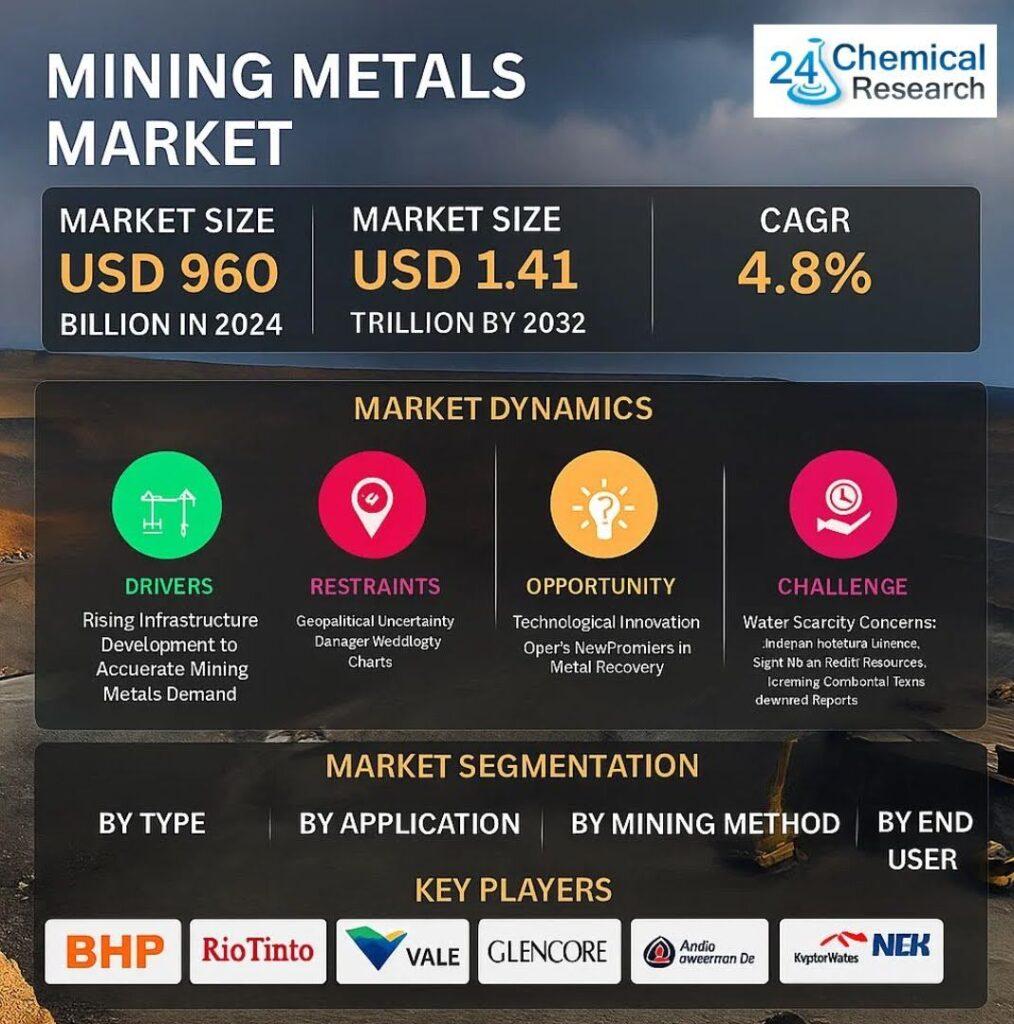Global mining metals sector is entering a new phase of strategic relevance, fueled by rising material needs for renewable energy infrastructure, electric vehicles, and advanced manufacturing. With a current valuation of USD 1.7 trillion in 2023, the market is forecast to reach USD 2.2 trillion by 2030, expanding at a compound annual growth rate (CAGR) of 3.2%.
From copper and aluminum to lithium and rare earth elements, the sector now sits at the core of national strategies for clean energy, digitalization, and supply chain security.

Get Full Report Here: https://www.24chemicalresearch.com/reports/274473/global-mining-metals-market-2024-2030-753
Clean Energy Transition Driving Global Metal Demand
Recent geopolitical and economic shifts have placed mining metals under the spotlight. According to a June 2025 Financial Times analysis, the International Energy Agency (IEA) has reiterated that electric vehicles (EVs) require six times more mineral input than internal combustion engine cars. Additionally, the construction of wind turbines, solar panels, and energy storage systems relies heavily on a steady and sustainable supply of mined materials.
A single wind turbine contains over 8,000 components, many of which are derived from metals like steel, aluminum, copper, and rare earths- highlighting the industry’s pivotal role in the green energy transformation.
Market Segmentation:
By Type
- Non-ferrous Metal
- Ferrous Metal
- Noble Metal
By Application
- Construction
- Chemical Industry
- Manufacturing
- Medical
- Other
Asia-Pacific Leads Global Supply Chain, But Sustainability Pressure Mounts
Asia-Pacific currently dominates global production, accounting for over 50% of global output, with China maintaining significant control over both upstream extraction and downstream processing. Countries like Indonesia and Australia are also emerging as leaders in nickel and lithium, respectively, to support battery production.
North America is ramping up activity through infrastructure investments and the onshoring of mineral supply chains for semiconductors and EVs. Europe, under its Green Deal framework, is boosting its demand for recycled and low-carbon metals, even as it tightens regulations around traditional extractive operations.
Africa and Latin America, rich in natural resources, are increasingly balancing resource nationalism with international investment. However, limited infrastructure and policy uncertainty remain barriers to growth.
Innovation, Circular Economy, and Strategic Supply Shaping Market Dynamics
The mining metals sector is evolving beyond traditional models. Innovations like AI-driven exploration, water-saving extraction, and digital supply chain monitoring are rapidly gaining traction. Meanwhile, the circular economy is becoming a viable revenue stream, with metal recovery and recycling technologies advancing quickly in Europe and Japan.
In the private sector, companies are investing in ESG-aligned extraction practices to retain their social license to operate, while governments continue to push for strategic mineral stockpiling and critical mineral alliances to mitigate trade risks.
Top Leading Key Players Covered
- Rio Tinto
- BHP Billiton
- Vale
- Glencore
- ArcelorMittal
- MMC Norilsk Nickel
- Ternium
- Codelco
- Barrick Gold
- Southern Copper Corporation
- China Shenhua Energy
- Mitsubishi Materials
- Newmont Corporation
- Grupo Mexico
- Alcoa Corporation
Download Sample Report: https://www.24chemicalresearch.com/download-sample/274473/global-mining-metals-market-2024-2030-753
Industry Challenges: Regulatory Pressure, Permitting Delays, and Resource Constraints
Despite the promising outlook, the mining metals industry faces serious headwinds. Ore grade declines- averaging 0.4% annually– are forcing companies to explore deeper and more remote sites, escalating operational costs. Environmental permitting in major economies now often exceeds five to seven years, slowing the rollout of new projects.
Regulatory scrutiny on carbon-intensive processes, particularly in steel and aluminum production, is tightening, while activist investor pressure and skilled labor shortages are forcing the industry to rethink workforce and governance strategies. Meanwhile, fluctuating commodity prices and critical mineral export controls– such as those recently enacted between China and the U.S.- continue to disrupt global trade flows.
About 24chemicalresearch
Founded in 2015, 24chemicalresearch has rapidly established itself as a leader in chemical market intelligence, serving clients including over 30 Fortune 500 companies. We provide data-driven insights through rigorous research methodologies, addressing key industry factors such as government policy, emerging technologies, and competitive landscapes.
- Plant-level capacity tracking
- Real-time price monitoring
- Techno-economic feasibility studies
With a dedicated team of researchers possessing over a decade of experience, we focus on delivering actionable, timely, and high-quality reports to help clients achieve their strategic goals. Our mission is to be the most trusted resource for market insights in the chemical and materials industries.
Website: https://www.24chemicalresearch.com
The macro analyst desk brings highly sought after financial news based on market analysis, insider news and company filings.
